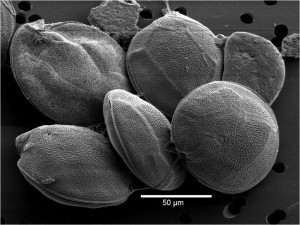Ciguatera: an emerging problem
Some species of benthic dinoflagellates of tropical and/or subtropical regions have apparently expanded their distribution in the last decades towards more temperate regions. Particularly, the genus Gambierdiscus, responsible for ciguatera, constitute a key aspect in the study of noxious algae in the last years due to the danger they pose for the human health. In the Iberian peninsula, species of the Gambierdiscus genus have not yet been detected, but the Macarronesic area where the Canary Islands are located is considered a region threatened by ciguatera. This genus was recently reported in the island of Madeira, and cases were also recorded in the Wild islands (Islas Salvajes), between Madeira and Tenerife. The first case of ciguatera was detected in 2004 and it was caused by the consumption of amberfish. In 2008 more cases of intoxication were recorded, and from that year on, cases have been detected almost every year.

Gambierdiscus lives attached on hard substrates, like macroalgae, thanks to the sticky properties of a mucilaginous matrix secreted by their cells.
Gambierdiscus are flattened and round like lentils…but 100 times smaller !


